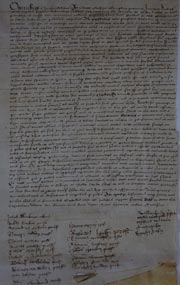 |
 |
 |
 |
 |
 |
 |
|
Byland Abbey: History
Byland Abbey: Buildings
|
The Dissolution In February 1535, the royal commissioners, Layton and
Legh, who were notorious for their rigorous visitation of the religious
houses in the north of England, arrived at Byland to conduct an
investigation of the monastery. The ruthless pair sought to find
damning evidence to support
the closure of the religious houses, and also to encourage newcomers
to leave the monastic life. Whilst Layton and Legh did not seem
to find any
traces of superstition at Byland, they did accuse one monk, Henry
Topping, of self-abuse. This did not jeopardise Henry’s pension, for
he was awarded the annual sum of £5 8s 5d following the dissolution
of his abbey. Layton and Legh also reported that Thomas Morton
sought to leave
the monastic life, and the fact that he does not appear on the
pension list indicates that Thomas did indeed depart around this
time.(76) The commissioners
were concerned too with the financial state of the abbey and recorded
that Byland’s rents amounted to 500 marks, and that the founder, Roger
de Mowbray, was buried with his wife in the window of the chapter-house.(77) It
has recently been suggested that this was probably a memorial to
the founder, and not his burial site.
On 30 November 1538, Abbot John
Alanbridge (1525-1538),
Prior Robert Barker and the twenty-four remaining monks of Byland
gathered in
their chapter-house
for the final time and surrendered their abbey, with all its property,
to the Crown. An inventory was taken and a valuation of the abbey
and its lands
made. The following month Henry VIII received a letter from Layton
and Legh reporting that they had achieved the quiet surrender of
Byland and other
religious houses in the North, and reassuring the king that they
had not perceived any ‘murmur or grudges in any behalf; on the contrary,
they had been thankfully received.’(78) Four
months later, in March 1539, each monk of Byland was awarded a
pension relative to his standing within
the
community, in return for his compliance. John Harrison was not
included on this list, since he had received the rectory of Old
Byland. |
